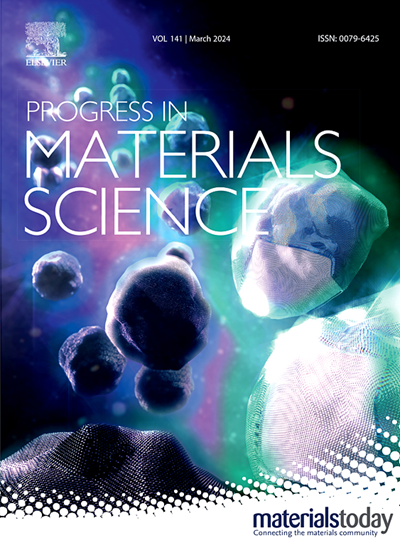Ultra-high temperature piezoelectric crystals: Properties, structures and applications
IF 40
1区 材料科学
Q1 MATERIALS SCIENCE, MULTIDISCIPLINARY
引用次数: 0
Abstract
Piezoelectric single crystals with high melting points are crucial for ultra-high temperature sensing applications, such as structural health monitoring and non-destructive testing of special equipment. Despite significant progress in recent years, a systematic and comprehensive review of high-temperature piezoelectric crystals has yet to be conducted. In this review, we delve into the crystal growth, electrical properties, crystal structures, and practical applications, including the representative rare-earth calcium oxyborate crystals [ReCaO(BO3)3, ReCOB, Re: rare earth], langasite-type crystals (La3Ga5SiO14, LGS; La3Ta0.5Ga5.5O14, LTG, etc.), along with several single crystals (Ba2TiSi2O8, AlN, Ca2Al2SiO7, etc.). In particular, the temperature dependence of electrical resistivity, dielectric, piezoelectric, elastic, and electromechanical properties are reviewed. The piezoelectric crosstalk and the impact of crystal cuts on electrical properties are discussed. Moreover, the origin of the relationship between order–disorder structures and properties of piezoelectric single crystals, as well as the conductivity mechanism, are clarified using theoretical calculations. The behaviours of these crystals in extreme conditions sensing applications are summarized, such as surface acoustic wave (SAW) sensors, vibrational sensors, acoustic emission (AE) sensors, pressure sensors, suggesting innovative design strategies for sensors with high sensitivity and performance robustness.
超高温压电晶体:性能、结构与应用
具有高熔点的压电单晶在结构健康监测和特种设备无损检测等超高温传感应用中具有重要意义。尽管近年来取得了重大进展,但对高温压电晶体还没有进行系统和全面的综述。本文从晶体生长、电学性质、晶体结构和实际应用等方面进行了综述,包括具有代表性的稀土氧硼酸钙晶体[ReCaO(BO3)3, ReCOB, Re:稀土],langasite型晶体(La3Ga5SiO14, LGS; La3Ta0.5Ga5.5O14, LTG等),以及几种单晶(Ba2TiSi2O8, AlN, Ca2Al2SiO7等)。特别是,电阻率,介电,压电,弹性和机电性能的温度依赖性进行了审查。讨论了压电串扰和晶体切割对电性能的影响。此外,通过理论计算阐明了压电单晶有序无序结构与性能关系的起源,以及导电机理。总结了这些晶体在表面声波(SAW)传感器、振动传感器、声发射(AE)传感器、压力传感器等极端条件传感应用中的行为,提出了高灵敏度和性能鲁棒性传感器的创新设计策略。
本文章由计算机程序翻译,如有差异,请以英文原文为准。
求助全文
约1分钟内获得全文
求助全文
来源期刊

Progress in Materials Science
工程技术-材料科学:综合
CiteScore
59.60
自引率
0.80%
发文量
101
审稿时长
11.4 months
期刊介绍:
Progress in Materials Science is a journal that publishes authoritative and critical reviews of recent advances in the science of materials. The focus of the journal is on the fundamental aspects of materials science, particularly those concerning microstructure and nanostructure and their relationship to properties. Emphasis is also placed on the thermodynamics, kinetics, mechanisms, and modeling of processes within materials, as well as the understanding of material properties in engineering and other applications.
The journal welcomes reviews from authors who are active leaders in the field of materials science and have a strong scientific track record. Materials of interest include metallic, ceramic, polymeric, biological, medical, and composite materials in all forms.
Manuscripts submitted to Progress in Materials Science are generally longer than those found in other research journals. While the focus is on invited reviews, interested authors may submit a proposal for consideration. Non-invited manuscripts are required to be preceded by the submission of a proposal. Authors publishing in Progress in Materials Science have the option to publish their research via subscription or open access. Open access publication requires the author or research funder to meet a publication fee (APC).
Abstracting and indexing services for Progress in Materials Science include Current Contents, Science Citation Index Expanded, Materials Science Citation Index, Chemical Abstracts, Engineering Index, INSPEC, and Scopus.
 求助内容:
求助内容: 应助结果提醒方式:
应助结果提醒方式:


